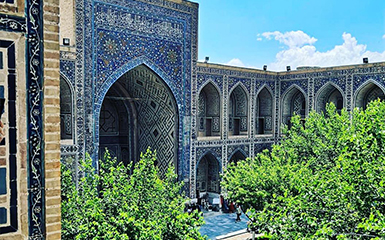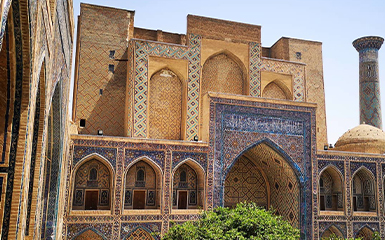Bahauddin complex
Char Minar
Lyab-I Hauz complex
Poi Kalan complex
The Ark Citadel
Bolo Haouz Mosque
Kalan Minaret
Islam Khodja complex
Itchan Kala
Kalta Minaret
Kunya Ark
Kutlugmurat Anak
Alla Kuli Khan
Muhammad Rahim Khan
Muhammed Emin Khan
Pahlawan Mahmud
Tash Hauli
Juma Mosque
Andijan
Muynak
Rabati Malik
The Ulug Beg observatory, called Gurkani Zij, is located two kilometres from the centre of the Uzbek city of Samarkand. Today there are only ruins of the observatory and a museum.
The observatory was built in 1424-1428 by the Timurid prince Ulugh Beg for the observations of astronomers at the Ulugh beg Madrasah. The observatory that Ilkhan Hulagu had built for Nasir ad-Din at-Tusi in Maragheh in the East Azerbaijan province of Iran served as a model.
By observing the sun with the sextant for many years, Ulugh Beg and his astronomers Jamshid al-Kashi and Qadi Zada al-Rumi determined the inclination of the ecliptic at 23 ° 30 ' and 17 "(corresponds to the value at that time to a few degree seconds) and the sidereal year at 365 days 6 hours 10 minutes and 8 seconds (with a difference of 58 seconds compared to today's value). This accuracy is comparable to the determination of the tropical year as 365 days 5 hours 49 minutes and 20 seconds (deviation 35 seconds) by the Chinese astronomer Guo Shoujing with a 10 meter high gnomon at the Gaocheng Observatory near Dengfeng, which he used in 1278 to create the Shou Shi calendar performed. They also examined the precession of the equinoxes.
The mathematical and astronomical work was summarized in the Zij-i-Sultani. It contains the mathematical basics (such as tables of trigonometric functions), the observation methods, tables of planetary movements, astrological chapters and a new star catalogue. Based on al-Kashi's star catalogue Chagani Zij, the astronomers compiled a star catalogue with 1018 stars with position information in the years 1420 to 1437. 992 stars were measured in Samarkand itself; the catalogue was supplemented by 26 stars from Al-Sufi's catalogue of 964, which cannot be observed from Samarkand. This is the first catalogue since Ptolemy based on new measurements. Before that, the Muslim astronomers had essentially taken the star tables from the Almagest and corrected them for precession. With a mean deviation of 11 arc seconds for longitudes and 8 for latitudes, the accuracy clearly exceeded the Almagest (58 and 37 seconds) and was only exceeded by Tycho Brahe more than a hundred years later.
After Ulugh Beg's murder, the observatory was destroyed, but the astronomer Ali al-Qushji (d. 1474) escaped to Tabriz with a copy of the star tables. Later he taught at the madrasah at Hagia Sophia in Istanbul. From there the tablets came to Western Europe. In Istanbul, around 1575, Taqi ad-Din took Ulug Beg's observatory as a model for the observatory of the Ottoman Sultan Murad III.
Only the underground part of the sextant was preserved and was discovered and excavated in 1908. The Ulugh Beg Astronomical Institute of the Uzbek Academy of Sciences and Samarkand State University have maintained a teaching observatory in Samarkand since 2006.


